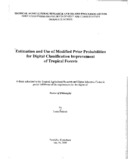Estimation and use of modified prior probabilities for digital classification improvement of tropical forests
Description
Tesis (Ph. D.) -- CATIE. Escuela de Posgrado, Turrialba (Costa Rica), 2000 111 páginas Ilus. Tab Referencias inician en la página 31
Abstract
This dissertation addresses the problem of tropical forest classification using remotely sensed data. Traditional remote sensing methods have had probleMON for discriminating tropical secondary and disturbed forests. As a consequence, important information is lacking, that is required for research in biogeography and for a complete assessment of carbon dioxide flows from land-use and land-cover change. To improve the discrimination of tropical secondary and logged forests using remotely sensed data, a Bayesian classification approach was investigated. The prior probabilities were modified as a function of the pixel's geographical context, which is a non-parametric strategy to incorporate information obtained from ancillary data into the maximun likelihood classification. The method has been proposed before, but found little application, because it presented practical probleMON for obtaining prior probability estimates. The dissertation describes and tests a data analysis procedure that generates prior probability estimates from class frequencies modeled with ancillary data and a Mahalanobis Distance threshold of previously classifies pixels. The method produces a pixel sample size that is large enough to estimates class prior pprobabilities in numerous geographies strata, which is particularly desirable for the study of large and complex landscapes, in which stratified random sampling for obtaining class frequency estimates is economically prohibitive. An experiment is presented, in which the procedure made it possible to estimate 537 sets of prior probabilities for an entire Landsat TM scene of central Costa Rica. After modifying the prior probabilities, the overall classification consistency of the training sites improved from 74.6 por ciento (traditional equal priors maximun likelihood classification) to 91.9 por ciento, while the overall classification accuracy of sites controlled in the field by independent studies improved from 68.7 por ciento to 89.0 por ciento. The classification accuracy was most improved for the spectrally similar forest categories. The usefulness of spectral enhancement using the Normalized Difference Vegetation Index (NDVI) and Tasseled Cap features were also investigated. The results of spectral analysis and of 18 classification experiments using different band and index combination are presented. Weak evidence was found to support the hypothesis that spectral enhancement might help the discrimination of tropical secondary, logged, and undisturbed forest categories.
Keywords
Publisher
CATIE, Turrialba (Costa Rica)
URI (Permanet link to cite or share this item)
https://repositorio.catie.ac.cr/handle/11554/4972Collections
- Tesis [3110]


